Circular Economy: The Path to Sustainable Development and Social Impact
VerifiedAdded on 2022/12/17
|11
|3961
|1
AI Summary
This document discusses the concept of circular economy and its emergence from theories such as Cradle to Cradle and the blue economy systems approach. It explores the progress of circular economy in the city of Chittagong, Bangladesh, and proposes actions that local and international companies and the local government can take to support its development. The document highlights the barriers, enabling factors, and opportunities for the growth of circular economy.
Contribute Materials
Your contribution can guide someone’s learning journey. Share your
documents today.
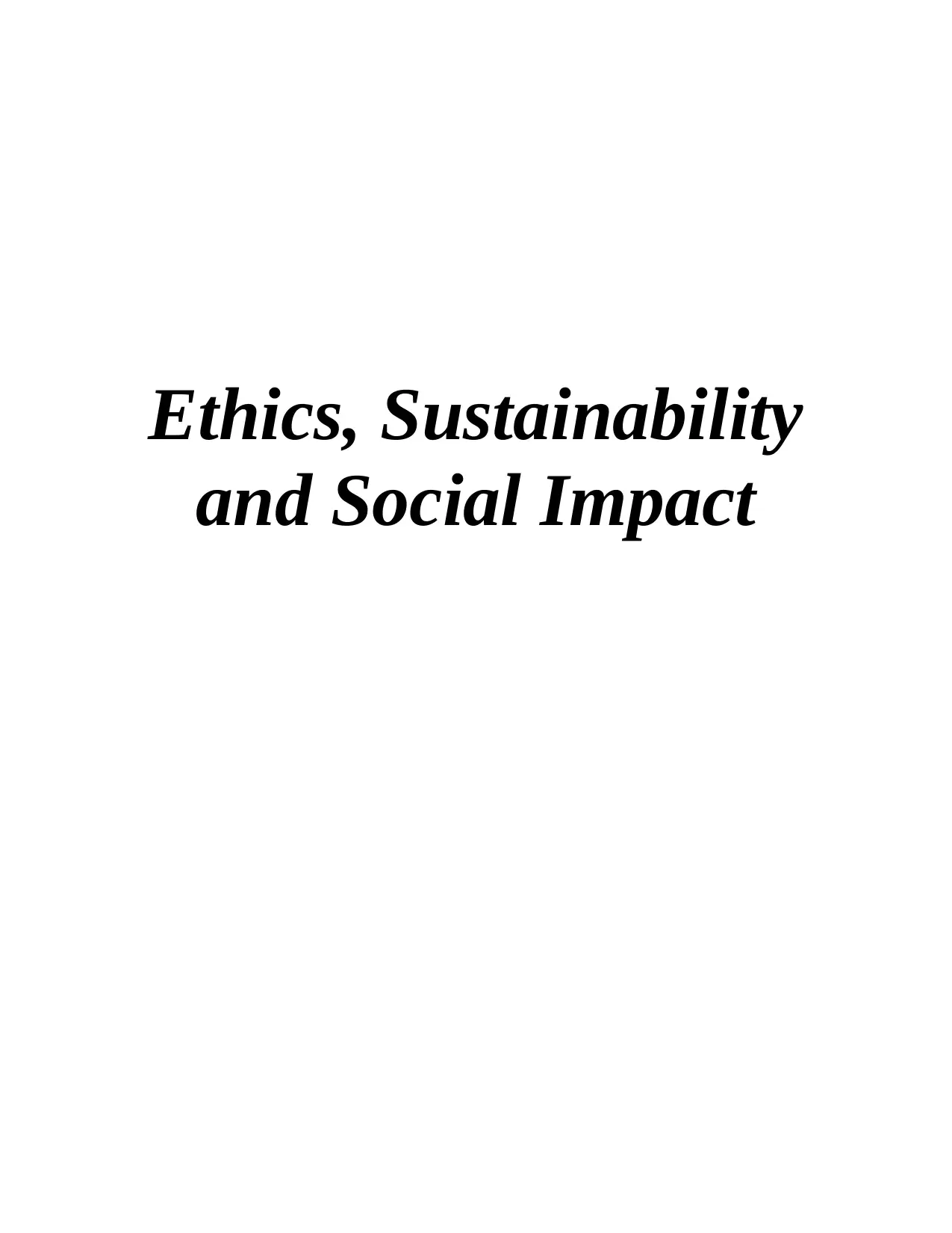
Ethics, Sustainability
and Social Impact
and Social Impact
Secure Best Marks with AI Grader
Need help grading? Try our AI Grader for instant feedback on your assignments.
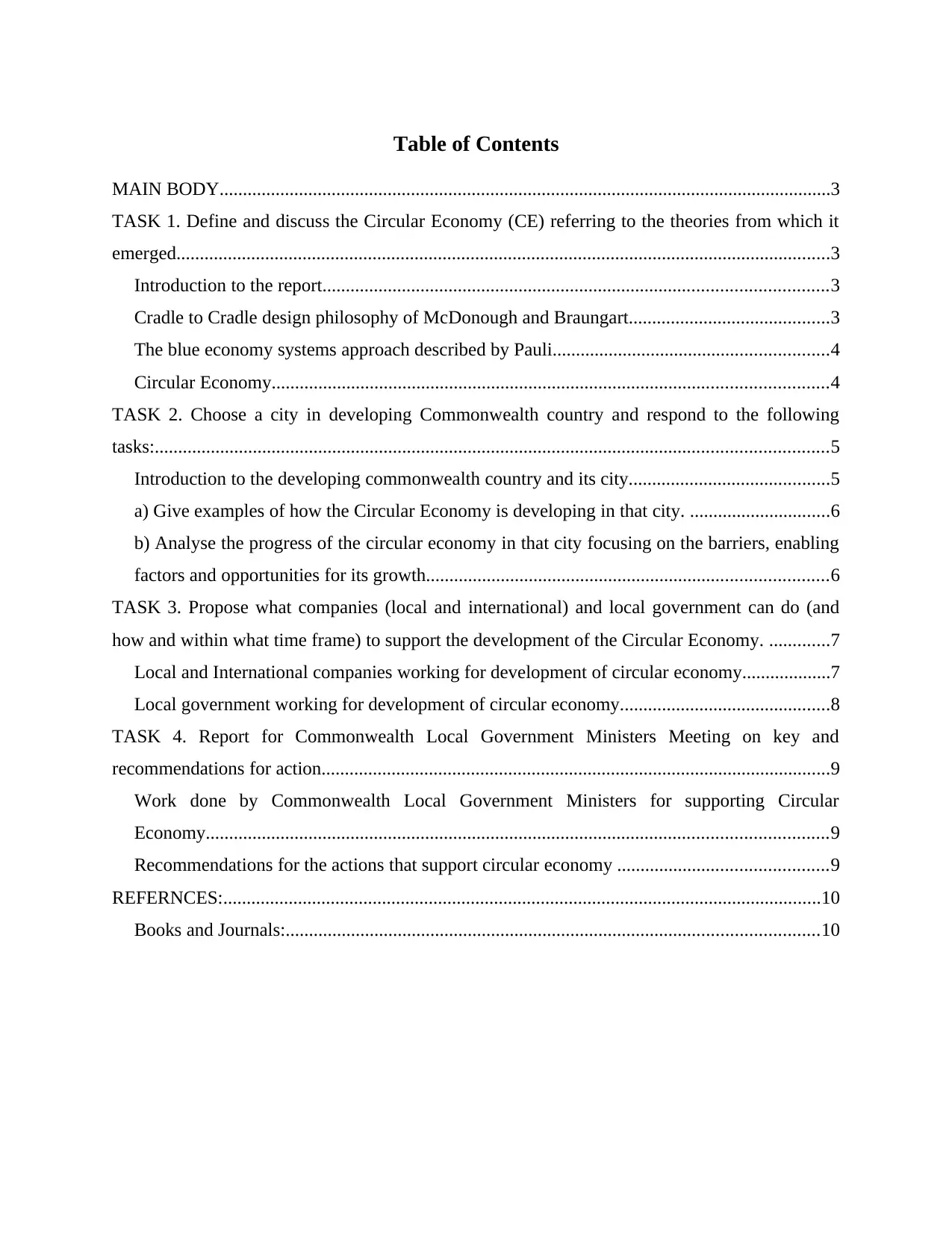
Table of Contents
MAIN BODY...................................................................................................................................3
TASK 1. Define and discuss the Circular Economy (CE) referring to the theories from which it
emerged............................................................................................................................................3
Introduction to the report............................................................................................................3
Cradle to Cradle design philosophy of McDonough and Braungart...........................................3
The blue economy systems approach described by Pauli...........................................................4
Circular Economy.......................................................................................................................4
TASK 2. Choose a city in developing Commonwealth country and respond to the following
tasks:................................................................................................................................................5
Introduction to the developing commonwealth country and its city...........................................5
a) Give examples of how the Circular Economy is developing in that city. ..............................6
b) Analyse the progress of the circular economy in that city focusing on the barriers, enabling
factors and opportunities for its growth......................................................................................6
TASK 3. Propose what companies (local and international) and local government can do (and
how and within what time frame) to support the development of the Circular Economy. .............7
Local and International companies working for development of circular economy...................7
Local government working for development of circular economy.............................................8
TASK 4. Report for Commonwealth Local Government Ministers Meeting on key and
recommendations for action.............................................................................................................9
Work done by Commonwealth Local Government Ministers for supporting Circular
Economy.....................................................................................................................................9
Recommendations for the actions that support circular economy .............................................9
REFERNCES:................................................................................................................................10
Books and Journals:..................................................................................................................10
MAIN BODY...................................................................................................................................3
TASK 1. Define and discuss the Circular Economy (CE) referring to the theories from which it
emerged............................................................................................................................................3
Introduction to the report............................................................................................................3
Cradle to Cradle design philosophy of McDonough and Braungart...........................................3
The blue economy systems approach described by Pauli...........................................................4
Circular Economy.......................................................................................................................4
TASK 2. Choose a city in developing Commonwealth country and respond to the following
tasks:................................................................................................................................................5
Introduction to the developing commonwealth country and its city...........................................5
a) Give examples of how the Circular Economy is developing in that city. ..............................6
b) Analyse the progress of the circular economy in that city focusing on the barriers, enabling
factors and opportunities for its growth......................................................................................6
TASK 3. Propose what companies (local and international) and local government can do (and
how and within what time frame) to support the development of the Circular Economy. .............7
Local and International companies working for development of circular economy...................7
Local government working for development of circular economy.............................................8
TASK 4. Report for Commonwealth Local Government Ministers Meeting on key and
recommendations for action.............................................................................................................9
Work done by Commonwealth Local Government Ministers for supporting Circular
Economy.....................................................................................................................................9
Recommendations for the actions that support circular economy .............................................9
REFERNCES:................................................................................................................................10
Books and Journals:..................................................................................................................10
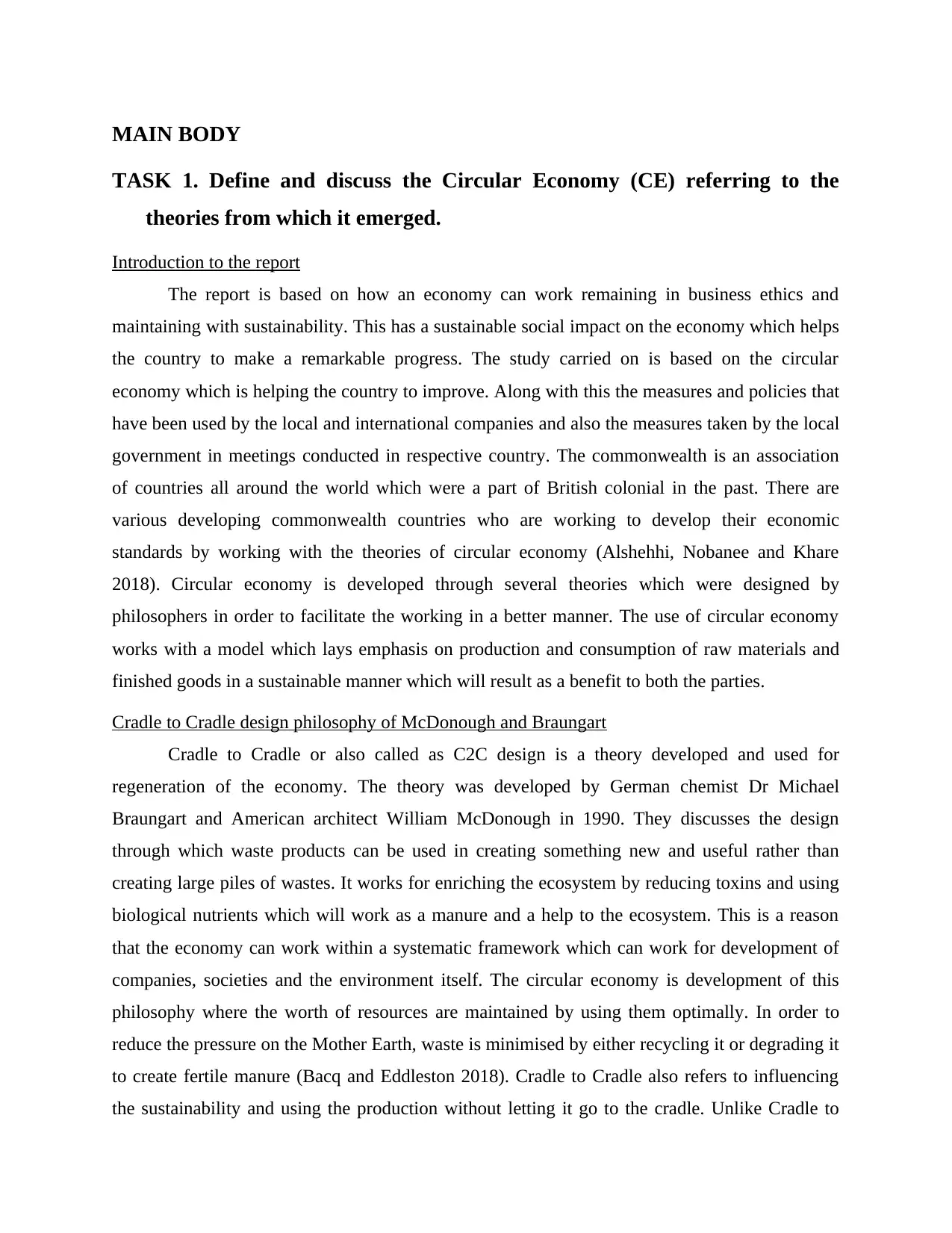
MAIN BODY
TASK 1. Define and discuss the Circular Economy (CE) referring to the
theories from which it emerged.
Introduction to the report
The report is based on how an economy can work remaining in business ethics and
maintaining with sustainability. This has a sustainable social impact on the economy which helps
the country to make a remarkable progress. The study carried on is based on the circular
economy which is helping the country to improve. Along with this the measures and policies that
have been used by the local and international companies and also the measures taken by the local
government in meetings conducted in respective country. The commonwealth is an association
of countries all around the world which were a part of British colonial in the past. There are
various developing commonwealth countries who are working to develop their economic
standards by working with the theories of circular economy (Alshehhi, Nobanee and Khare
2018). Circular economy is developed through several theories which were designed by
philosophers in order to facilitate the working in a better manner. The use of circular economy
works with a model which lays emphasis on production and consumption of raw materials and
finished goods in a sustainable manner which will result as a benefit to both the parties.
Cradle to Cradle design philosophy of McDonough and Braungart
Cradle to Cradle or also called as C2C design is a theory developed and used for
regeneration of the economy. The theory was developed by German chemist Dr Michael
Braungart and American architect William McDonough in 1990. They discusses the design
through which waste products can be used in creating something new and useful rather than
creating large piles of wastes. It works for enriching the ecosystem by reducing toxins and using
biological nutrients which will work as a manure and a help to the ecosystem. This is a reason
that the economy can work within a systematic framework which can work for development of
companies, societies and the environment itself. The circular economy is development of this
philosophy where the worth of resources are maintained by using them optimally. In order to
reduce the pressure on the Mother Earth, waste is minimised by either recycling it or degrading it
to create fertile manure (Bacq and Eddleston 2018). Cradle to Cradle also refers to influencing
the sustainability and using the production without letting it go to the cradle. Unlike Cradle to
TASK 1. Define and discuss the Circular Economy (CE) referring to the
theories from which it emerged.
Introduction to the report
The report is based on how an economy can work remaining in business ethics and
maintaining with sustainability. This has a sustainable social impact on the economy which helps
the country to make a remarkable progress. The study carried on is based on the circular
economy which is helping the country to improve. Along with this the measures and policies that
have been used by the local and international companies and also the measures taken by the local
government in meetings conducted in respective country. The commonwealth is an association
of countries all around the world which were a part of British colonial in the past. There are
various developing commonwealth countries who are working to develop their economic
standards by working with the theories of circular economy (Alshehhi, Nobanee and Khare
2018). Circular economy is developed through several theories which were designed by
philosophers in order to facilitate the working in a better manner. The use of circular economy
works with a model which lays emphasis on production and consumption of raw materials and
finished goods in a sustainable manner which will result as a benefit to both the parties.
Cradle to Cradle design philosophy of McDonough and Braungart
Cradle to Cradle or also called as C2C design is a theory developed and used for
regeneration of the economy. The theory was developed by German chemist Dr Michael
Braungart and American architect William McDonough in 1990. They discusses the design
through which waste products can be used in creating something new and useful rather than
creating large piles of wastes. It works for enriching the ecosystem by reducing toxins and using
biological nutrients which will work as a manure and a help to the ecosystem. This is a reason
that the economy can work within a systematic framework which can work for development of
companies, societies and the environment itself. The circular economy is development of this
philosophy where the worth of resources are maintained by using them optimally. In order to
reduce the pressure on the Mother Earth, waste is minimised by either recycling it or degrading it
to create fertile manure (Bacq and Eddleston 2018). Cradle to Cradle also refers to influencing
the sustainability and using the production without letting it go to the cradle. Unlike Cradle to
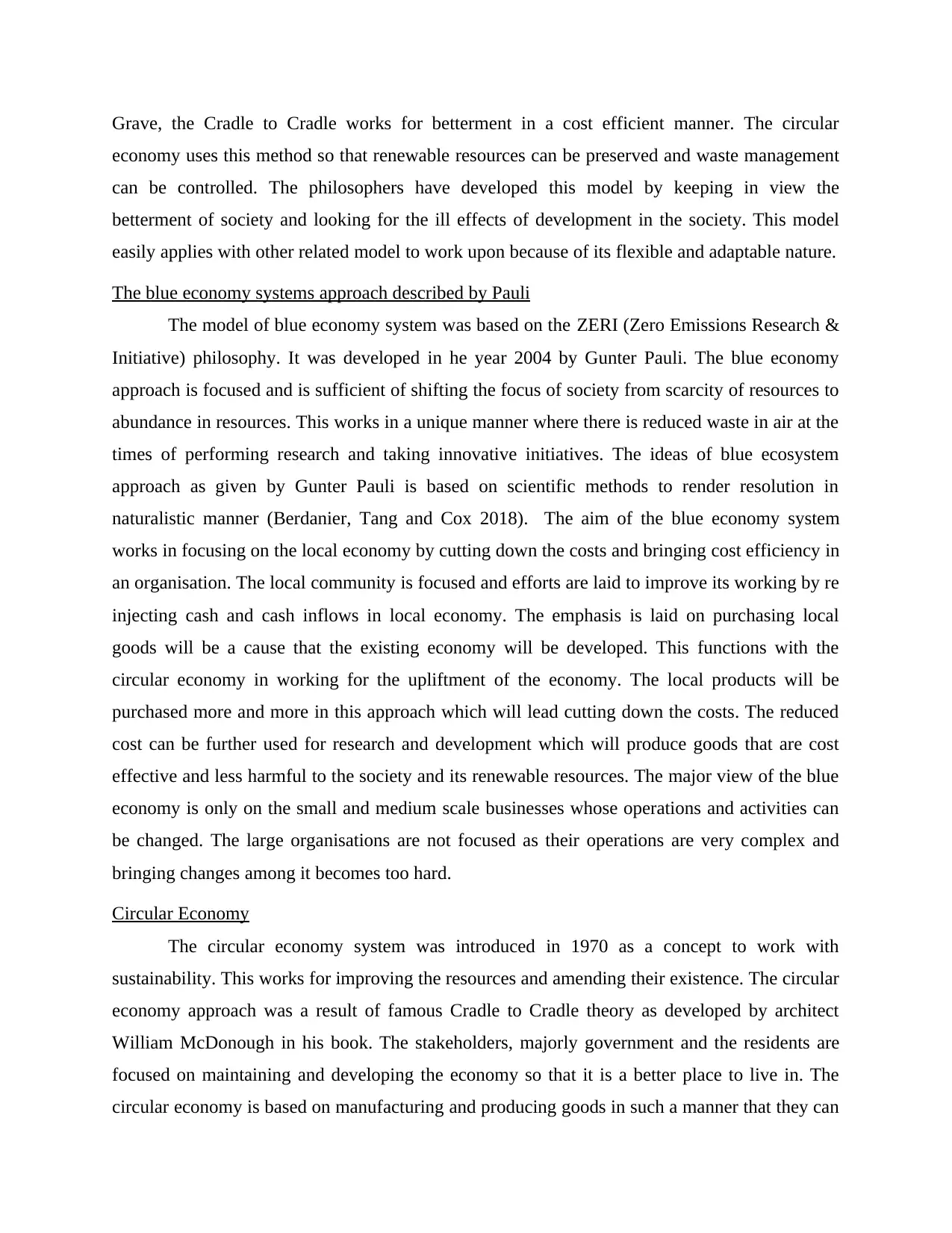
Grave, the Cradle to Cradle works for betterment in a cost efficient manner. The circular
economy uses this method so that renewable resources can be preserved and waste management
can be controlled. The philosophers have developed this model by keeping in view the
betterment of society and looking for the ill effects of development in the society. This model
easily applies with other related model to work upon because of its flexible and adaptable nature.
The blue economy systems approach described by Pauli
The model of blue economy system was based on the ZERI (Zero Emissions Research &
Initiative) philosophy. It was developed in he year 2004 by Gunter Pauli. The blue economy
approach is focused and is sufficient of shifting the focus of society from scarcity of resources to
abundance in resources. This works in a unique manner where there is reduced waste in air at the
times of performing research and taking innovative initiatives. The ideas of blue ecosystem
approach as given by Gunter Pauli is based on scientific methods to render resolution in
naturalistic manner (Berdanier, Tang and Cox 2018). The aim of the blue economy system
works in focusing on the local economy by cutting down the costs and bringing cost efficiency in
an organisation. The local community is focused and efforts are laid to improve its working by re
injecting cash and cash inflows in local economy. The emphasis is laid on purchasing local
goods will be a cause that the existing economy will be developed. This functions with the
circular economy in working for the upliftment of the economy. The local products will be
purchased more and more in this approach which will lead cutting down the costs. The reduced
cost can be further used for research and development which will produce goods that are cost
effective and less harmful to the society and its renewable resources. The major view of the blue
economy is only on the small and medium scale businesses whose operations and activities can
be changed. The large organisations are not focused as their operations are very complex and
bringing changes among it becomes too hard.
Circular Economy
The circular economy system was introduced in 1970 as a concept to work with
sustainability. This works for improving the resources and amending their existence. The circular
economy approach was a result of famous Cradle to Cradle theory as developed by architect
William McDonough in his book. The stakeholders, majorly government and the residents are
focused on maintaining and developing the economy so that it is a better place to live in. The
circular economy is based on manufacturing and producing goods in such a manner that they can
economy uses this method so that renewable resources can be preserved and waste management
can be controlled. The philosophers have developed this model by keeping in view the
betterment of society and looking for the ill effects of development in the society. This model
easily applies with other related model to work upon because of its flexible and adaptable nature.
The blue economy systems approach described by Pauli
The model of blue economy system was based on the ZERI (Zero Emissions Research &
Initiative) philosophy. It was developed in he year 2004 by Gunter Pauli. The blue economy
approach is focused and is sufficient of shifting the focus of society from scarcity of resources to
abundance in resources. This works in a unique manner where there is reduced waste in air at the
times of performing research and taking innovative initiatives. The ideas of blue ecosystem
approach as given by Gunter Pauli is based on scientific methods to render resolution in
naturalistic manner (Berdanier, Tang and Cox 2018). The aim of the blue economy system
works in focusing on the local economy by cutting down the costs and bringing cost efficiency in
an organisation. The local community is focused and efforts are laid to improve its working by re
injecting cash and cash inflows in local economy. The emphasis is laid on purchasing local
goods will be a cause that the existing economy will be developed. This functions with the
circular economy in working for the upliftment of the economy. The local products will be
purchased more and more in this approach which will lead cutting down the costs. The reduced
cost can be further used for research and development which will produce goods that are cost
effective and less harmful to the society and its renewable resources. The major view of the blue
economy is only on the small and medium scale businesses whose operations and activities can
be changed. The large organisations are not focused as their operations are very complex and
bringing changes among it becomes too hard.
Circular Economy
The circular economy system was introduced in 1970 as a concept to work with
sustainability. This works for improving the resources and amending their existence. The circular
economy approach was a result of famous Cradle to Cradle theory as developed by architect
William McDonough in his book. The stakeholders, majorly government and the residents are
focused on maintaining and developing the economy so that it is a better place to live in. The
circular economy is based on manufacturing and producing goods in such a manner that they can
Secure Best Marks with AI Grader
Need help grading? Try our AI Grader for instant feedback on your assignments.
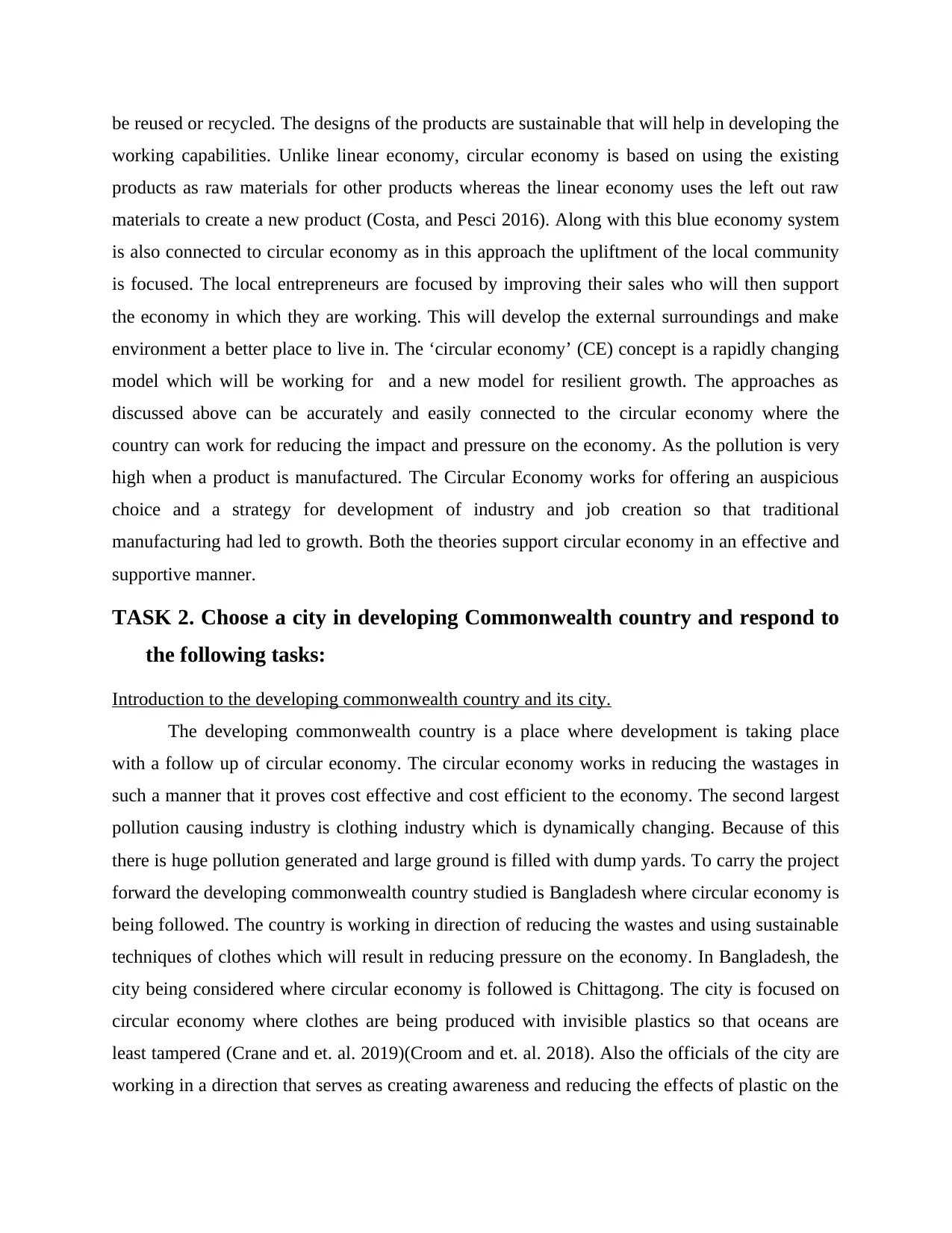
be reused or recycled. The designs of the products are sustainable that will help in developing the
working capabilities. Unlike linear economy, circular economy is based on using the existing
products as raw materials for other products whereas the linear economy uses the left out raw
materials to create a new product (Costa, and Pesci 2016). Along with this blue economy system
is also connected to circular economy as in this approach the upliftment of the local community
is focused. The local entrepreneurs are focused by improving their sales who will then support
the economy in which they are working. This will develop the external surroundings and make
environment a better place to live in. The ‘circular economy’ (CE) concept is a rapidly changing
model which will be working for and a new model for resilient growth. The approaches as
discussed above can be accurately and easily connected to the circular economy where the
country can work for reducing the impact and pressure on the economy. As the pollution is very
high when a product is manufactured. The Circular Economy works for offering an auspicious
choice and a strategy for development of industry and job creation so that traditional
manufacturing had led to growth. Both the theories support circular economy in an effective and
supportive manner.
TASK 2. Choose a city in developing Commonwealth country and respond to
the following tasks:
Introduction to the developing commonwealth country and its city.
The developing commonwealth country is a place where development is taking place
with a follow up of circular economy. The circular economy works in reducing the wastages in
such a manner that it proves cost effective and cost efficient to the economy. The second largest
pollution causing industry is clothing industry which is dynamically changing. Because of this
there is huge pollution generated and large ground is filled with dump yards. To carry the project
forward the developing commonwealth country studied is Bangladesh where circular economy is
being followed. The country is working in direction of reducing the wastes and using sustainable
techniques of clothes which will result in reducing pressure on the economy. In Bangladesh, the
city being considered where circular economy is followed is Chittagong. The city is focused on
circular economy where clothes are being produced with invisible plastics so that oceans are
least tampered (Crane and et. al. 2019)(Croom and et. al. 2018). Also the officials of the city are
working in a direction that serves as creating awareness and reducing the effects of plastic on the
working capabilities. Unlike linear economy, circular economy is based on using the existing
products as raw materials for other products whereas the linear economy uses the left out raw
materials to create a new product (Costa, and Pesci 2016). Along with this blue economy system
is also connected to circular economy as in this approach the upliftment of the local community
is focused. The local entrepreneurs are focused by improving their sales who will then support
the economy in which they are working. This will develop the external surroundings and make
environment a better place to live in. The ‘circular economy’ (CE) concept is a rapidly changing
model which will be working for and a new model for resilient growth. The approaches as
discussed above can be accurately and easily connected to the circular economy where the
country can work for reducing the impact and pressure on the economy. As the pollution is very
high when a product is manufactured. The Circular Economy works for offering an auspicious
choice and a strategy for development of industry and job creation so that traditional
manufacturing had led to growth. Both the theories support circular economy in an effective and
supportive manner.
TASK 2. Choose a city in developing Commonwealth country and respond to
the following tasks:
Introduction to the developing commonwealth country and its city.
The developing commonwealth country is a place where development is taking place
with a follow up of circular economy. The circular economy works in reducing the wastages in
such a manner that it proves cost effective and cost efficient to the economy. The second largest
pollution causing industry is clothing industry which is dynamically changing. Because of this
there is huge pollution generated and large ground is filled with dump yards. To carry the project
forward the developing commonwealth country studied is Bangladesh where circular economy is
being followed. The country is working in direction of reducing the wastes and using sustainable
techniques of clothes which will result in reducing pressure on the economy. In Bangladesh, the
city being considered where circular economy is followed is Chittagong. The city is focused on
circular economy where clothes are being produced with invisible plastics so that oceans are
least tampered (Crane and et. al. 2019)(Croom and et. al. 2018). Also the officials of the city are
working in a direction that serves as creating awareness and reducing the effects of plastic on the
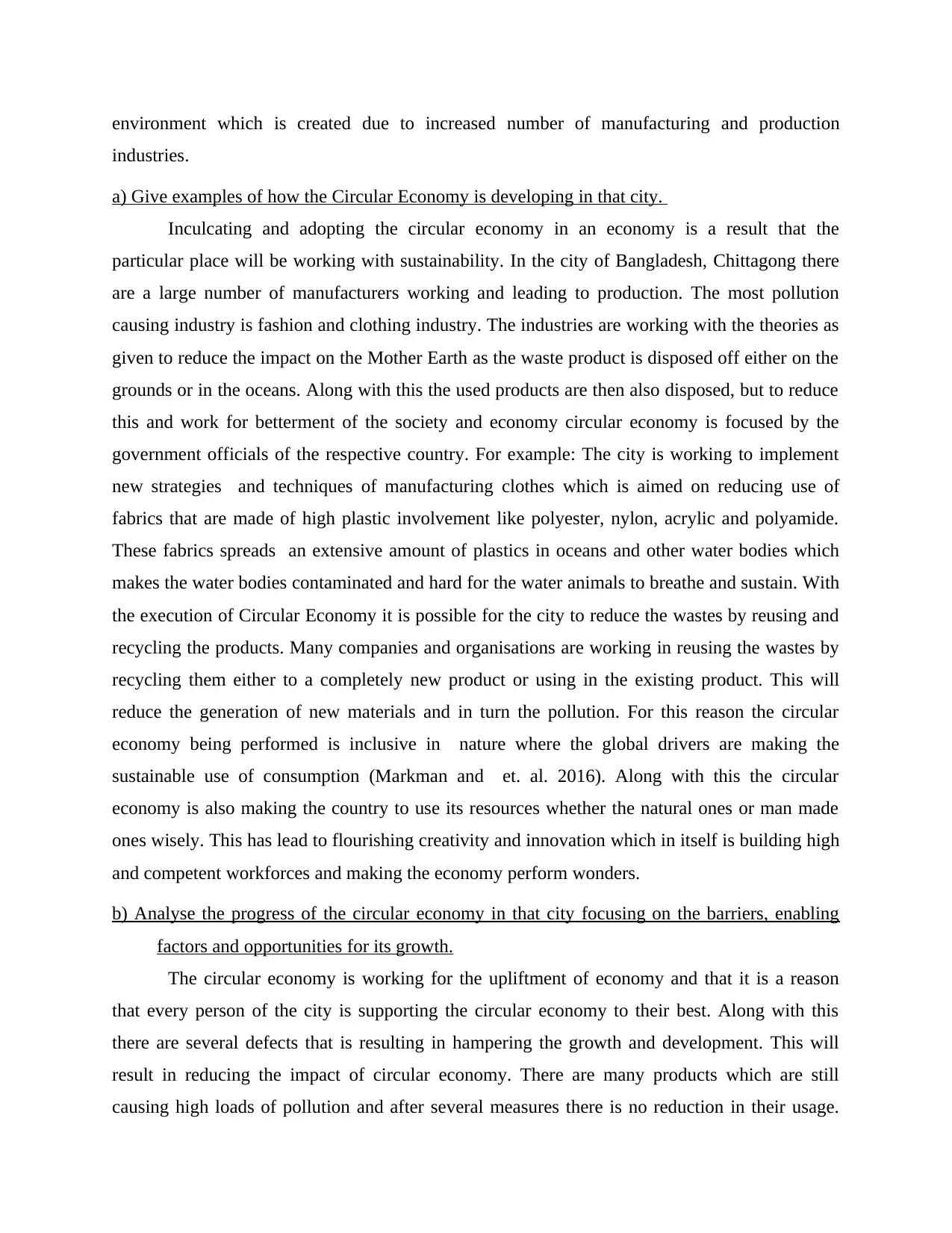
environment which is created due to increased number of manufacturing and production
industries.
a) Give examples of how the Circular Economy is developing in that city.
Inculcating and adopting the circular economy in an economy is a result that the
particular place will be working with sustainability. In the city of Bangladesh, Chittagong there
are a large number of manufacturers working and leading to production. The most pollution
causing industry is fashion and clothing industry. The industries are working with the theories as
given to reduce the impact on the Mother Earth as the waste product is disposed off either on the
grounds or in the oceans. Along with this the used products are then also disposed, but to reduce
this and work for betterment of the society and economy circular economy is focused by the
government officials of the respective country. For example: The city is working to implement
new strategies and techniques of manufacturing clothes which is aimed on reducing use of
fabrics that are made of high plastic involvement like polyester, nylon, acrylic and polyamide.
These fabrics spreads an extensive amount of plastics in oceans and other water bodies which
makes the water bodies contaminated and hard for the water animals to breathe and sustain. With
the execution of Circular Economy it is possible for the city to reduce the wastes by reusing and
recycling the products. Many companies and organisations are working in reusing the wastes by
recycling them either to a completely new product or using in the existing product. This will
reduce the generation of new materials and in turn the pollution. For this reason the circular
economy being performed is inclusive in nature where the global drivers are making the
sustainable use of consumption (Markman and et. al. 2016). Along with this the circular
economy is also making the country to use its resources whether the natural ones or man made
ones wisely. This has lead to flourishing creativity and innovation which in itself is building high
and competent workforces and making the economy perform wonders.
b) Analyse the progress of the circular economy in that city focusing on the barriers, enabling
factors and opportunities for its growth.
The circular economy is working for the upliftment of economy and that it is a reason
that every person of the city is supporting the circular economy to their best. Along with this
there are several defects that is resulting in hampering the growth and development. This will
result in reducing the impact of circular economy. There are many products which are still
causing high loads of pollution and after several measures there is no reduction in their usage.
industries.
a) Give examples of how the Circular Economy is developing in that city.
Inculcating and adopting the circular economy in an economy is a result that the
particular place will be working with sustainability. In the city of Bangladesh, Chittagong there
are a large number of manufacturers working and leading to production. The most pollution
causing industry is fashion and clothing industry. The industries are working with the theories as
given to reduce the impact on the Mother Earth as the waste product is disposed off either on the
grounds or in the oceans. Along with this the used products are then also disposed, but to reduce
this and work for betterment of the society and economy circular economy is focused by the
government officials of the respective country. For example: The city is working to implement
new strategies and techniques of manufacturing clothes which is aimed on reducing use of
fabrics that are made of high plastic involvement like polyester, nylon, acrylic and polyamide.
These fabrics spreads an extensive amount of plastics in oceans and other water bodies which
makes the water bodies contaminated and hard for the water animals to breathe and sustain. With
the execution of Circular Economy it is possible for the city to reduce the wastes by reusing and
recycling the products. Many companies and organisations are working in reusing the wastes by
recycling them either to a completely new product or using in the existing product. This will
reduce the generation of new materials and in turn the pollution. For this reason the circular
economy being performed is inclusive in nature where the global drivers are making the
sustainable use of consumption (Markman and et. al. 2016). Along with this the circular
economy is also making the country to use its resources whether the natural ones or man made
ones wisely. This has lead to flourishing creativity and innovation which in itself is building high
and competent workforces and making the economy perform wonders.
b) Analyse the progress of the circular economy in that city focusing on the barriers, enabling
factors and opportunities for its growth.
The circular economy is working for the upliftment of economy and that it is a reason
that every person of the city is supporting the circular economy to their best. Along with this
there are several defects that is resulting in hampering the growth and development. This will
result in reducing the impact of circular economy. There are many products which are still
causing high loads of pollution and after several measures there is no reduction in their usage.
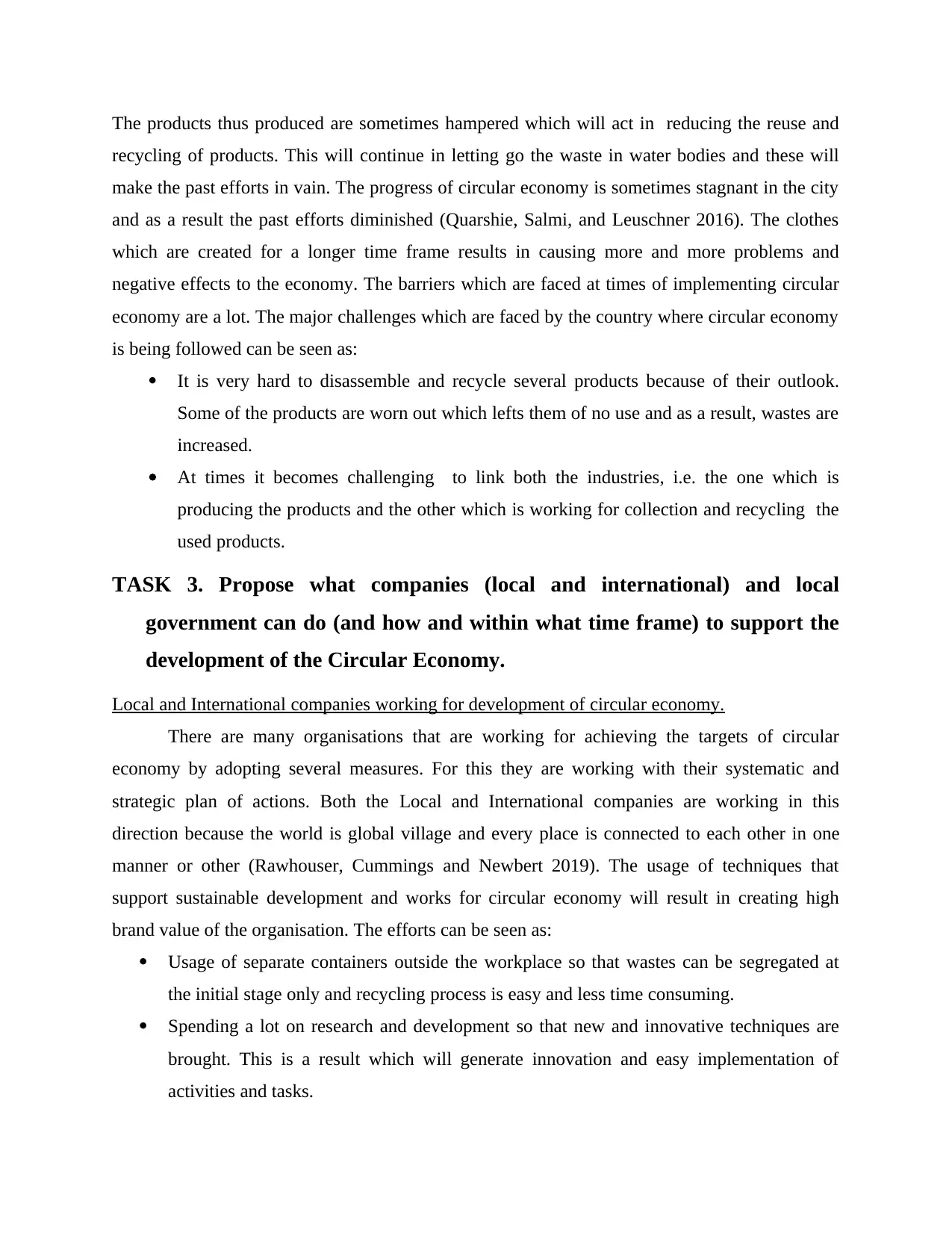
The products thus produced are sometimes hampered which will act in reducing the reuse and
recycling of products. This will continue in letting go the waste in water bodies and these will
make the past efforts in vain. The progress of circular economy is sometimes stagnant in the city
and as a result the past efforts diminished (Quarshie, Salmi, and Leuschner 2016). The clothes
which are created for a longer time frame results in causing more and more problems and
negative effects to the economy. The barriers which are faced at times of implementing circular
economy are a lot. The major challenges which are faced by the country where circular economy
is being followed can be seen as:
It is very hard to disassemble and recycle several products because of their outlook.
Some of the products are worn out which lefts them of no use and as a result, wastes are
increased.
At times it becomes challenging to link both the industries, i.e. the one which is
producing the products and the other which is working for collection and recycling the
used products.
TASK 3. Propose what companies (local and international) and local
government can do (and how and within what time frame) to support the
development of the Circular Economy.
Local and International companies working for development of circular economy.
There are many organisations that are working for achieving the targets of circular
economy by adopting several measures. For this they are working with their systematic and
strategic plan of actions. Both the Local and International companies are working in this
direction because the world is global village and every place is connected to each other in one
manner or other (Rawhouser, Cummings and Newbert 2019). The usage of techniques that
support sustainable development and works for circular economy will result in creating high
brand value of the organisation. The efforts can be seen as:
Usage of separate containers outside the workplace so that wastes can be segregated at
the initial stage only and recycling process is easy and less time consuming.
Spending a lot on research and development so that new and innovative techniques are
brought. This is a result which will generate innovation and easy implementation of
activities and tasks.
recycling of products. This will continue in letting go the waste in water bodies and these will
make the past efforts in vain. The progress of circular economy is sometimes stagnant in the city
and as a result the past efforts diminished (Quarshie, Salmi, and Leuschner 2016). The clothes
which are created for a longer time frame results in causing more and more problems and
negative effects to the economy. The barriers which are faced at times of implementing circular
economy are a lot. The major challenges which are faced by the country where circular economy
is being followed can be seen as:
It is very hard to disassemble and recycle several products because of their outlook.
Some of the products are worn out which lefts them of no use and as a result, wastes are
increased.
At times it becomes challenging to link both the industries, i.e. the one which is
producing the products and the other which is working for collection and recycling the
used products.
TASK 3. Propose what companies (local and international) and local
government can do (and how and within what time frame) to support the
development of the Circular Economy.
Local and International companies working for development of circular economy.
There are many organisations that are working for achieving the targets of circular
economy by adopting several measures. For this they are working with their systematic and
strategic plan of actions. Both the Local and International companies are working in this
direction because the world is global village and every place is connected to each other in one
manner or other (Rawhouser, Cummings and Newbert 2019). The usage of techniques that
support sustainable development and works for circular economy will result in creating high
brand value of the organisation. The efforts can be seen as:
Usage of separate containers outside the workplace so that wastes can be segregated at
the initial stage only and recycling process is easy and less time consuming.
Spending a lot on research and development so that new and innovative techniques are
brought. This is a result which will generate innovation and easy implementation of
activities and tasks.
Paraphrase This Document
Need a fresh take? Get an instant paraphrase of this document with our AI Paraphraser
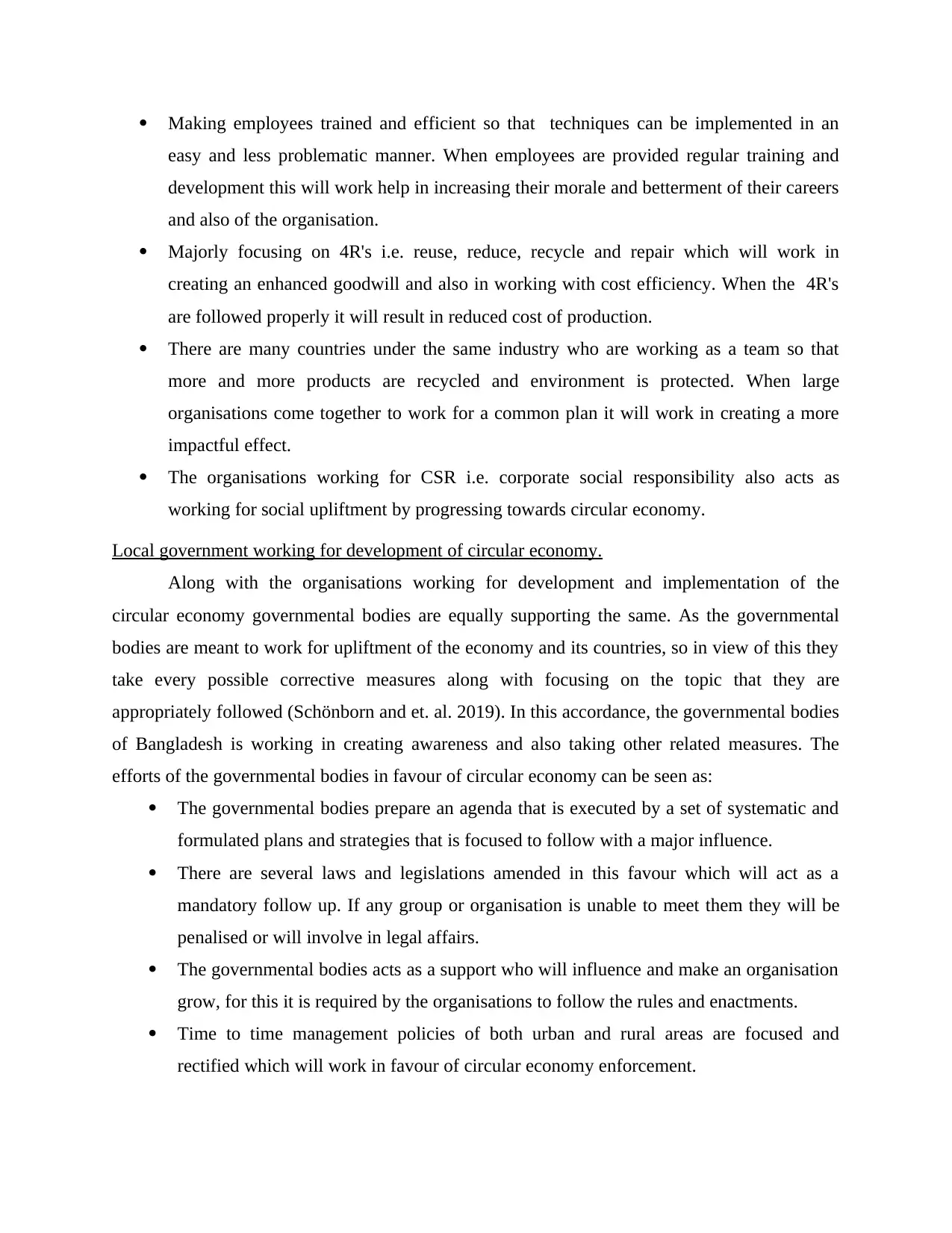
Making employees trained and efficient so that techniques can be implemented in an
easy and less problematic manner. When employees are provided regular training and
development this will work help in increasing their morale and betterment of their careers
and also of the organisation.
Majorly focusing on 4R's i.e. reuse, reduce, recycle and repair which will work in
creating an enhanced goodwill and also in working with cost efficiency. When the 4R's
are followed properly it will result in reduced cost of production.
There are many countries under the same industry who are working as a team so that
more and more products are recycled and environment is protected. When large
organisations come together to work for a common plan it will work in creating a more
impactful effect.
The organisations working for CSR i.e. corporate social responsibility also acts as
working for social upliftment by progressing towards circular economy.
Local government working for development of circular economy.
Along with the organisations working for development and implementation of the
circular economy governmental bodies are equally supporting the same. As the governmental
bodies are meant to work for upliftment of the economy and its countries, so in view of this they
take every possible corrective measures along with focusing on the topic that they are
appropriately followed (Schönborn and et. al. 2019). In this accordance, the governmental bodies
of Bangladesh is working in creating awareness and also taking other related measures. The
efforts of the governmental bodies in favour of circular economy can be seen as:
The governmental bodies prepare an agenda that is executed by a set of systematic and
formulated plans and strategies that is focused to follow with a major influence.
There are several laws and legislations amended in this favour which will act as a
mandatory follow up. If any group or organisation is unable to meet them they will be
penalised or will involve in legal affairs.
The governmental bodies acts as a support who will influence and make an organisation
grow, for this it is required by the organisations to follow the rules and enactments.
Time to time management policies of both urban and rural areas are focused and
rectified which will work in favour of circular economy enforcement.
easy and less problematic manner. When employees are provided regular training and
development this will work help in increasing their morale and betterment of their careers
and also of the organisation.
Majorly focusing on 4R's i.e. reuse, reduce, recycle and repair which will work in
creating an enhanced goodwill and also in working with cost efficiency. When the 4R's
are followed properly it will result in reduced cost of production.
There are many countries under the same industry who are working as a team so that
more and more products are recycled and environment is protected. When large
organisations come together to work for a common plan it will work in creating a more
impactful effect.
The organisations working for CSR i.e. corporate social responsibility also acts as
working for social upliftment by progressing towards circular economy.
Local government working for development of circular economy.
Along with the organisations working for development and implementation of the
circular economy governmental bodies are equally supporting the same. As the governmental
bodies are meant to work for upliftment of the economy and its countries, so in view of this they
take every possible corrective measures along with focusing on the topic that they are
appropriately followed (Schönborn and et. al. 2019). In this accordance, the governmental bodies
of Bangladesh is working in creating awareness and also taking other related measures. The
efforts of the governmental bodies in favour of circular economy can be seen as:
The governmental bodies prepare an agenda that is executed by a set of systematic and
formulated plans and strategies that is focused to follow with a major influence.
There are several laws and legislations amended in this favour which will act as a
mandatory follow up. If any group or organisation is unable to meet them they will be
penalised or will involve in legal affairs.
The governmental bodies acts as a support who will influence and make an organisation
grow, for this it is required by the organisations to follow the rules and enactments.
Time to time management policies of both urban and rural areas are focused and
rectified which will work in favour of circular economy enforcement.
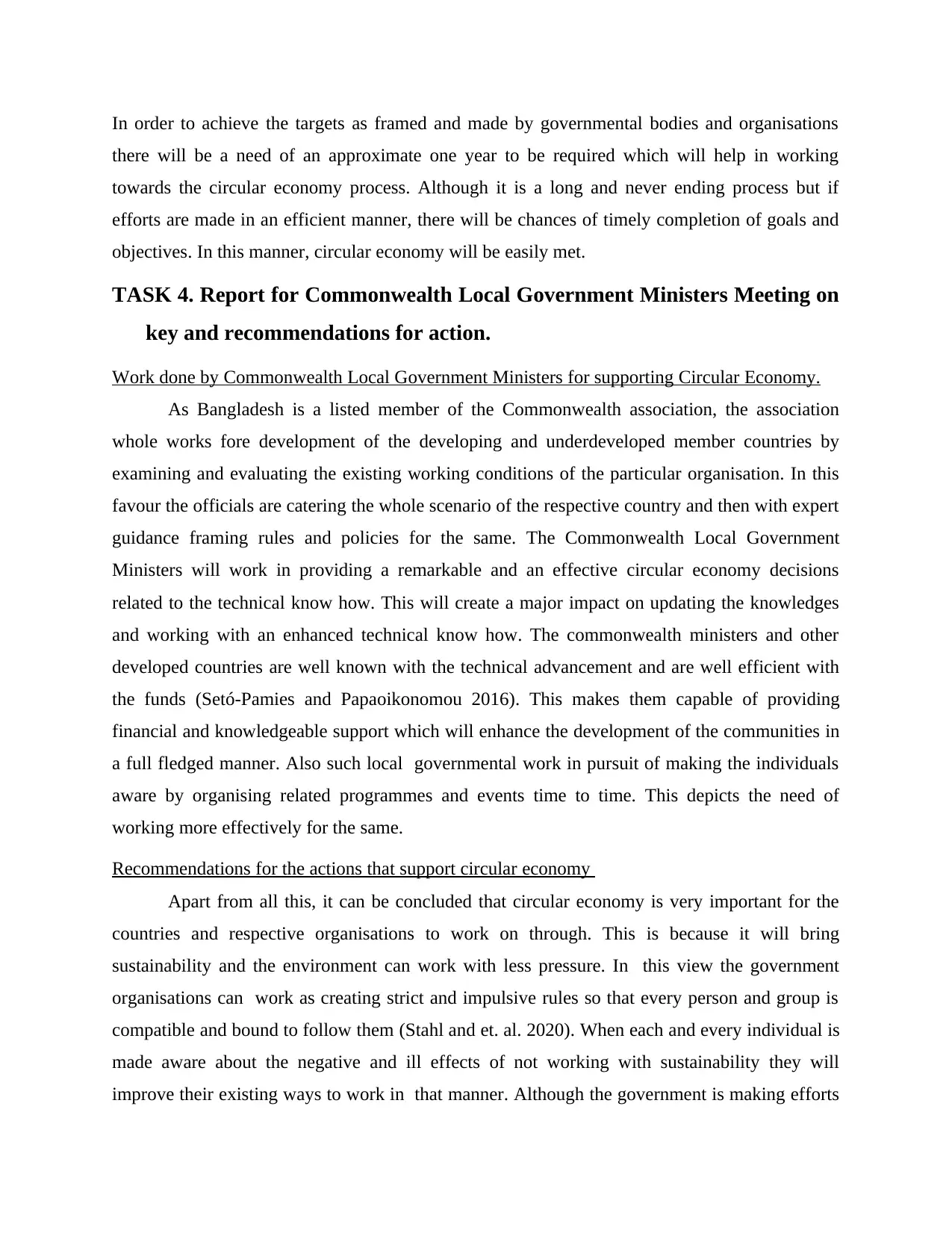
In order to achieve the targets as framed and made by governmental bodies and organisations
there will be a need of an approximate one year to be required which will help in working
towards the circular economy process. Although it is a long and never ending process but if
efforts are made in an efficient manner, there will be chances of timely completion of goals and
objectives. In this manner, circular economy will be easily met.
TASK 4. Report for Commonwealth Local Government Ministers Meeting on
key and recommendations for action.
Work done by Commonwealth Local Government Ministers for supporting Circular Economy.
As Bangladesh is a listed member of the Commonwealth association, the association
whole works fore development of the developing and underdeveloped member countries by
examining and evaluating the existing working conditions of the particular organisation. In this
favour the officials are catering the whole scenario of the respective country and then with expert
guidance framing rules and policies for the same. The Commonwealth Local Government
Ministers will work in providing a remarkable and an effective circular economy decisions
related to the technical know how. This will create a major impact on updating the knowledges
and working with an enhanced technical know how. The commonwealth ministers and other
developed countries are well known with the technical advancement and are well efficient with
the funds (Setó-Pamies and Papaoikonomou 2016). This makes them capable of providing
financial and knowledgeable support which will enhance the development of the communities in
a full fledged manner. Also such local governmental work in pursuit of making the individuals
aware by organising related programmes and events time to time. This depicts the need of
working more effectively for the same.
Recommendations for the actions that support circular economy
Apart from all this, it can be concluded that circular economy is very important for the
countries and respective organisations to work on through. This is because it will bring
sustainability and the environment can work with less pressure. In this view the government
organisations can work as creating strict and impulsive rules so that every person and group is
compatible and bound to follow them (Stahl and et. al. 2020). When each and every individual is
made aware about the negative and ill effects of not working with sustainability they will
improve their existing ways to work in that manner. Although the government is making efforts
there will be a need of an approximate one year to be required which will help in working
towards the circular economy process. Although it is a long and never ending process but if
efforts are made in an efficient manner, there will be chances of timely completion of goals and
objectives. In this manner, circular economy will be easily met.
TASK 4. Report for Commonwealth Local Government Ministers Meeting on
key and recommendations for action.
Work done by Commonwealth Local Government Ministers for supporting Circular Economy.
As Bangladesh is a listed member of the Commonwealth association, the association
whole works fore development of the developing and underdeveloped member countries by
examining and evaluating the existing working conditions of the particular organisation. In this
favour the officials are catering the whole scenario of the respective country and then with expert
guidance framing rules and policies for the same. The Commonwealth Local Government
Ministers will work in providing a remarkable and an effective circular economy decisions
related to the technical know how. This will create a major impact on updating the knowledges
and working with an enhanced technical know how. The commonwealth ministers and other
developed countries are well known with the technical advancement and are well efficient with
the funds (Setó-Pamies and Papaoikonomou 2016). This makes them capable of providing
financial and knowledgeable support which will enhance the development of the communities in
a full fledged manner. Also such local governmental work in pursuit of making the individuals
aware by organising related programmes and events time to time. This depicts the need of
working more effectively for the same.
Recommendations for the actions that support circular economy
Apart from all this, it can be concluded that circular economy is very important for the
countries and respective organisations to work on through. This is because it will bring
sustainability and the environment can work with less pressure. In this view the government
organisations can work as creating strict and impulsive rules so that every person and group is
compatible and bound to follow them (Stahl and et. al. 2020). When each and every individual is
made aware about the negative and ill effects of not working with sustainability they will
improve their existing ways to work in that manner. Although the government is making efforts
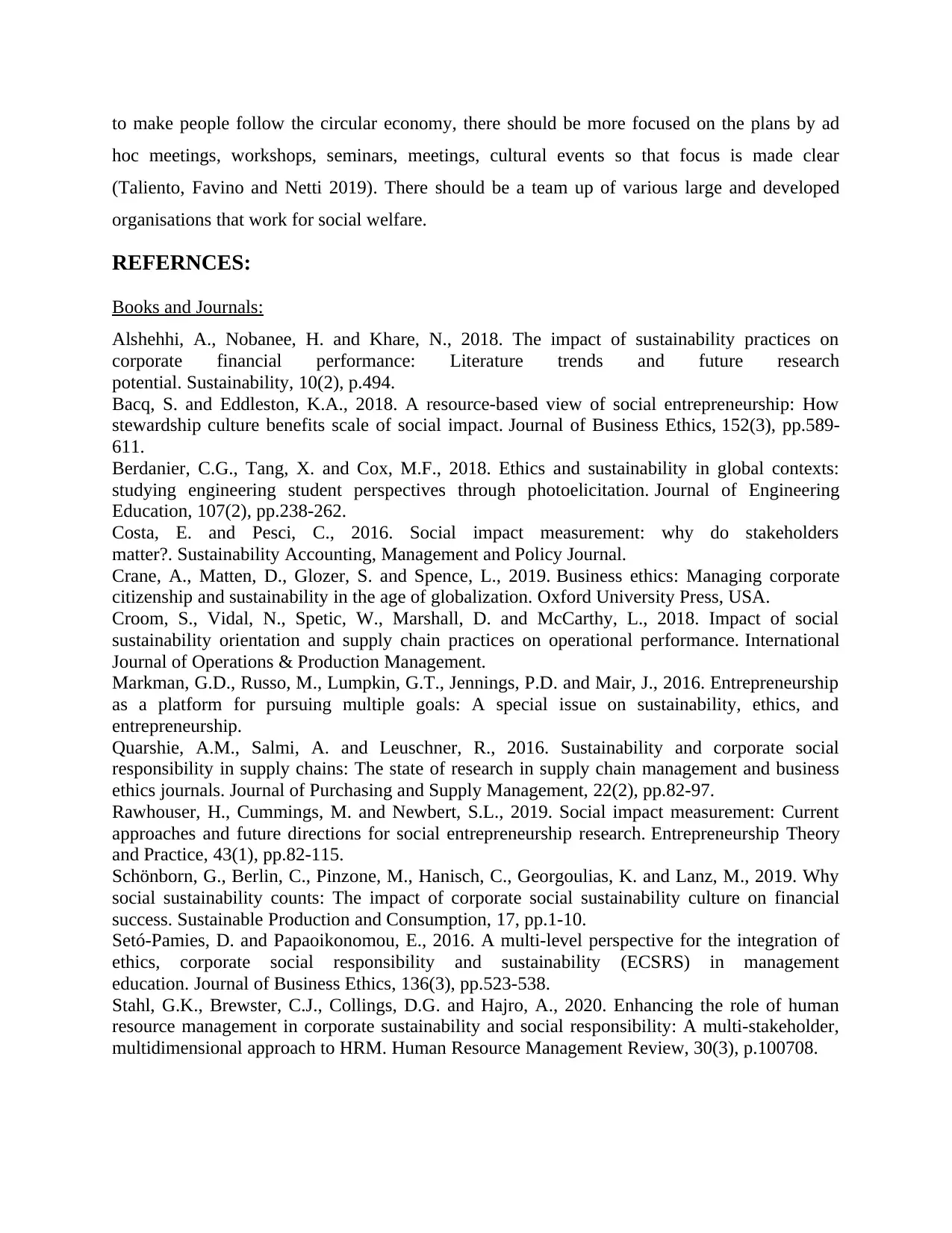
to make people follow the circular economy, there should be more focused on the plans by ad
hoc meetings, workshops, seminars, meetings, cultural events so that focus is made clear
(Taliento, Favino and Netti 2019). There should be a team up of various large and developed
organisations that work for social welfare.
REFERNCES:
Books and Journals:
Alshehhi, A., Nobanee, H. and Khare, N., 2018. The impact of sustainability practices on
corporate financial performance: Literature trends and future research
potential. Sustainability, 10(2), p.494.
Bacq, S. and Eddleston, K.A., 2018. A resource-based view of social entrepreneurship: How
stewardship culture benefits scale of social impact. Journal of Business Ethics, 152(3), pp.589-
611.
Berdanier, C.G., Tang, X. and Cox, M.F., 2018. Ethics and sustainability in global contexts:
studying engineering student perspectives through photoelicitation. Journal of Engineering
Education, 107(2), pp.238-262.
Costa, E. and Pesci, C., 2016. Social impact measurement: why do stakeholders
matter?. Sustainability Accounting, Management and Policy Journal.
Crane, A., Matten, D., Glozer, S. and Spence, L., 2019. Business ethics: Managing corporate
citizenship and sustainability in the age of globalization. Oxford University Press, USA.
Croom, S., Vidal, N., Spetic, W., Marshall, D. and McCarthy, L., 2018. Impact of social
sustainability orientation and supply chain practices on operational performance. International
Journal of Operations & Production Management.
Markman, G.D., Russo, M., Lumpkin, G.T., Jennings, P.D. and Mair, J., 2016. Entrepreneurship
as a platform for pursuing multiple goals: A special issue on sustainability, ethics, and
entrepreneurship.
Quarshie, A.M., Salmi, A. and Leuschner, R., 2016. Sustainability and corporate social
responsibility in supply chains: The state of research in supply chain management and business
ethics journals. Journal of Purchasing and Supply Management, 22(2), pp.82-97.
Rawhouser, H., Cummings, M. and Newbert, S.L., 2019. Social impact measurement: Current
approaches and future directions for social entrepreneurship research. Entrepreneurship Theory
and Practice, 43(1), pp.82-115.
Schönborn, G., Berlin, C., Pinzone, M., Hanisch, C., Georgoulias, K. and Lanz, M., 2019. Why
social sustainability counts: The impact of corporate social sustainability culture on financial
success. Sustainable Production and Consumption, 17, pp.1-10.
Setó-Pamies, D. and Papaoikonomou, E., 2016. A multi-level perspective for the integration of
ethics, corporate social responsibility and sustainability (ECSRS) in management
education. Journal of Business Ethics, 136(3), pp.523-538.
Stahl, G.K., Brewster, C.J., Collings, D.G. and Hajro, A., 2020. Enhancing the role of human
resource management in corporate sustainability and social responsibility: A multi-stakeholder,
multidimensional approach to HRM. Human Resource Management Review, 30(3), p.100708.
hoc meetings, workshops, seminars, meetings, cultural events so that focus is made clear
(Taliento, Favino and Netti 2019). There should be a team up of various large and developed
organisations that work for social welfare.
REFERNCES:
Books and Journals:
Alshehhi, A., Nobanee, H. and Khare, N., 2018. The impact of sustainability practices on
corporate financial performance: Literature trends and future research
potential. Sustainability, 10(2), p.494.
Bacq, S. and Eddleston, K.A., 2018. A resource-based view of social entrepreneurship: How
stewardship culture benefits scale of social impact. Journal of Business Ethics, 152(3), pp.589-
611.
Berdanier, C.G., Tang, X. and Cox, M.F., 2018. Ethics and sustainability in global contexts:
studying engineering student perspectives through photoelicitation. Journal of Engineering
Education, 107(2), pp.238-262.
Costa, E. and Pesci, C., 2016. Social impact measurement: why do stakeholders
matter?. Sustainability Accounting, Management and Policy Journal.
Crane, A., Matten, D., Glozer, S. and Spence, L., 2019. Business ethics: Managing corporate
citizenship and sustainability in the age of globalization. Oxford University Press, USA.
Croom, S., Vidal, N., Spetic, W., Marshall, D. and McCarthy, L., 2018. Impact of social
sustainability orientation and supply chain practices on operational performance. International
Journal of Operations & Production Management.
Markman, G.D., Russo, M., Lumpkin, G.T., Jennings, P.D. and Mair, J., 2016. Entrepreneurship
as a platform for pursuing multiple goals: A special issue on sustainability, ethics, and
entrepreneurship.
Quarshie, A.M., Salmi, A. and Leuschner, R., 2016. Sustainability and corporate social
responsibility in supply chains: The state of research in supply chain management and business
ethics journals. Journal of Purchasing and Supply Management, 22(2), pp.82-97.
Rawhouser, H., Cummings, M. and Newbert, S.L., 2019. Social impact measurement: Current
approaches and future directions for social entrepreneurship research. Entrepreneurship Theory
and Practice, 43(1), pp.82-115.
Schönborn, G., Berlin, C., Pinzone, M., Hanisch, C., Georgoulias, K. and Lanz, M., 2019. Why
social sustainability counts: The impact of corporate social sustainability culture on financial
success. Sustainable Production and Consumption, 17, pp.1-10.
Setó-Pamies, D. and Papaoikonomou, E., 2016. A multi-level perspective for the integration of
ethics, corporate social responsibility and sustainability (ECSRS) in management
education. Journal of Business Ethics, 136(3), pp.523-538.
Stahl, G.K., Brewster, C.J., Collings, D.G. and Hajro, A., 2020. Enhancing the role of human
resource management in corporate sustainability and social responsibility: A multi-stakeholder,
multidimensional approach to HRM. Human Resource Management Review, 30(3), p.100708.
Secure Best Marks with AI Grader
Need help grading? Try our AI Grader for instant feedback on your assignments.
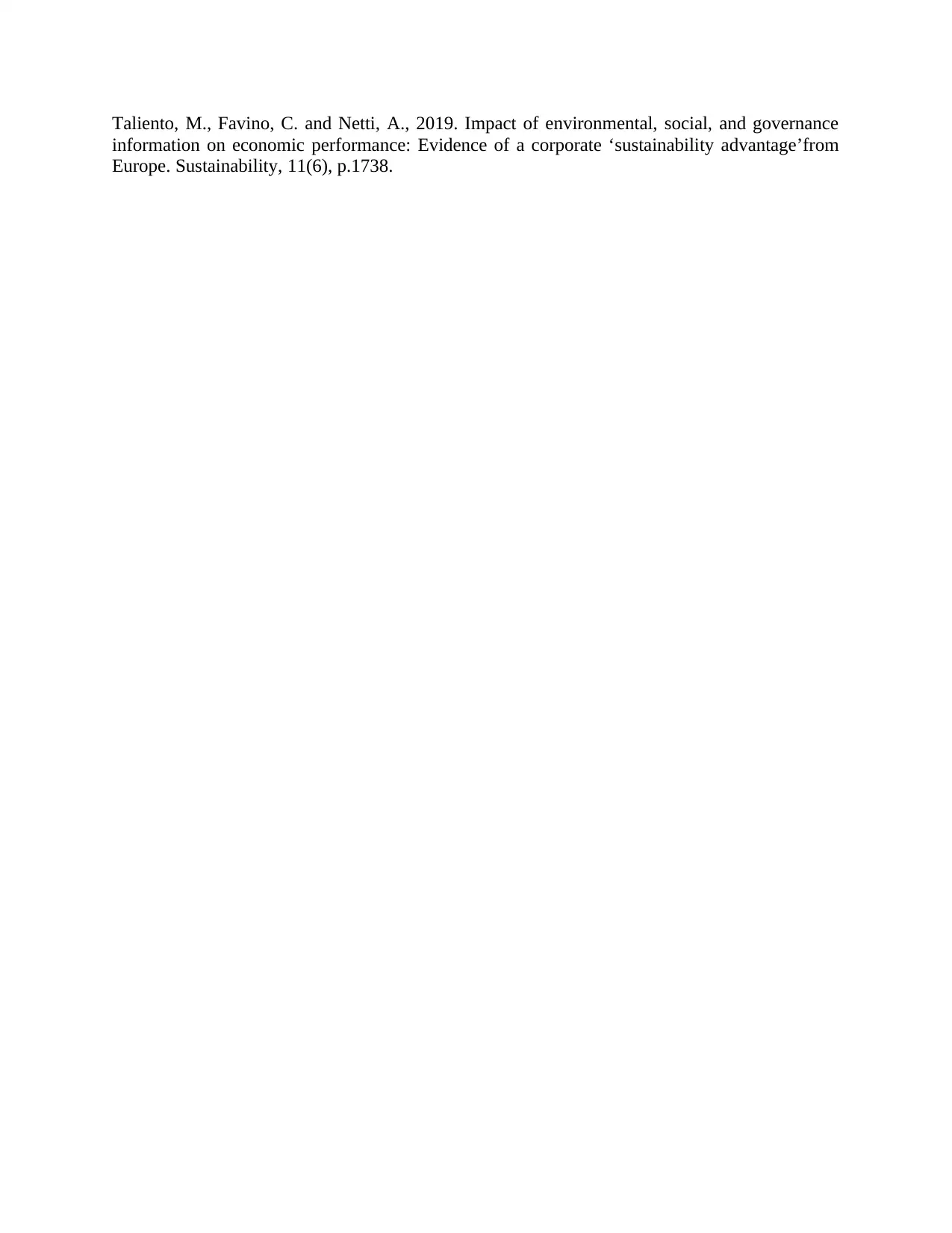
Taliento, M., Favino, C. and Netti, A., 2019. Impact of environmental, social, and governance
information on economic performance: Evidence of a corporate ‘sustainability advantage’from
Europe. Sustainability, 11(6), p.1738.
information on economic performance: Evidence of a corporate ‘sustainability advantage’from
Europe. Sustainability, 11(6), p.1738.
1 out of 11
Related Documents
Your All-in-One AI-Powered Toolkit for Academic Success.
+13062052269
info@desklib.com
Available 24*7 on WhatsApp / Email
![[object Object]](/_next/static/media/star-bottom.7253800d.svg)
Unlock your academic potential
© 2024 | Zucol Services PVT LTD | All rights reserved.





